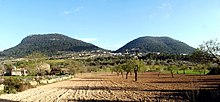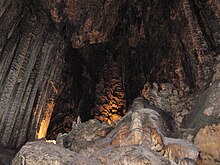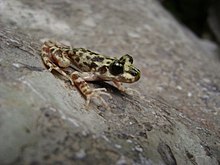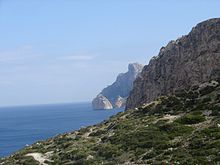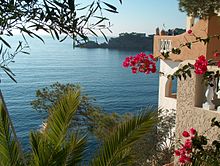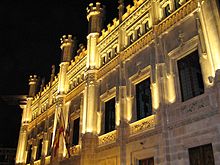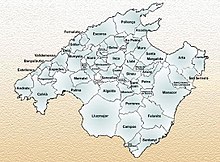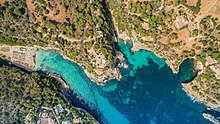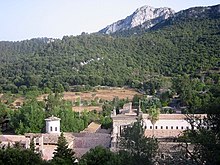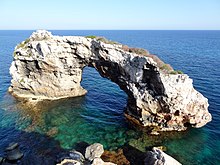Mallorca
| Mallorca | |||
|---|---|---|---|
|
|||
| location | |||
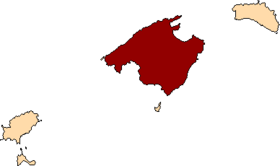 Balearic Islands |
|||
| Data | |||
| Capital | Palma | ||
| Largest community | Palma de Mallorca | ||
| Official languages | Catalan , Spanish | ||
| Population (2019) | 896.038 | ||
| surface | 3,603.7155 km² (including offshore islands: 3,622.5448 km²) | ||
| Population density | 243.1 inhabitants / km² | ||
| anthem | La Balanguera | ||
| Communities | 53 | ||
| Highest elevation | 1,445 meters ( Puig Major ) | ||
Mallorca ( Catalan [ məʎɔɾkə ], Castilian [ maʎoɾka ]; from Latin Baliaris Maior , later Maiorica - "the larger island", compared to Menorca ) too is Spain owned island in the western Mediterranean , about 170 kilometers from the Spanish mainland in Barcelona away .
Mallorca is the largest island of the Balearic group consisting of the Gymnesianen and Pine Islands , one autonomous community is within the Spanish state. The capital of the Balearic Islands, Palma, is located in Mallorca . The official languages are Catalan and Spanish . In addition, Mallorca is also the largest island belonging to Spain and the seventh largest Mediterranean island .
geography
Mallorca is east of the Spanish mainland between 39 ° 15'40 "and 39 ° 57'40" north latitude and 2 ° 19'38 "and 3 ° 28'42" east longitude. The island has a maximum east-west extension of 98 kilometers and a north-south extension of 78 kilometers. It is 3,603.7155 km², including smaller offshore islands 3,622.5448 km². Mallorca has a coastline of over 550 kilometers in length. The administrative area of Mallorca includes the main island of the Cabrera archipelago (18.36 km²) and the island of Sa Dragonera (2.88 km²).
Spatial division into landscape zones
Mallorca is divided into six landscape zones (catalan comarques , singular: comarca ).
Serra de Tramuntana

Yellow: Serra de Tramuntana
Dark blue: Raiguer
Brown: Pla de Mallorca
Light blue: Llevant
Green: Migjorn
Red: Palma (Ciutat de Mallorca)
First and foremost is the Serra de Tramuntana , a mountain range up to 15 kilometers wide with 11 peaks over 1000 meters high, which runs parallel to the north-west coast. The mountains extend over 90 kilometers in length from the island of Sa Dragonera in the southwest to Cap Formentor in the north. The highest point in the middle of the mountain range is the Puig Major at 1,445 meters . On the north-western slope of the mountains there are steep and rocky coastal areas with only small bays and stony beaches. The port of Sóller was built in the only larger bay .
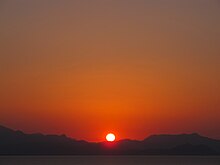
The Serra de Tramuntana is named after the cold north and west winds Tramuntana . Their mountain ranges form a climatic divide to the lower parts of the island, which means that they can enjoy milder winters, but also generally less rainy days. In the mountains, the uphill rain causes more frequent and heavier rainfall than in the other island regions.
On the side slopes of the mountains with their torrents , the torrents , fertile valleys have formed, with orange and lemon trees growing on the debris in the vicinity of Sóller . Tomatoes, beans and grapes are grown on terraced slopes ( Estellencs , Banyalbufar , Deià , Valldemossa ). The Serra de Tramuntana region is populated very differently. The total number of inhabitants is 104,904 (as of 2007), with the largest communities Calvià and Pollença being at the south and north end of the mountains.
Raiguer
Adjacent to the Serra de Tramuntana, the Es Raiguer region lies on the south-eastern slope of the mountain range between the La Victoria peninsula and the urban region of the capital Palma . It is a transition zone from the mountains to the Es Plà plain in the middle of Mallorca. There is plenty of water here, but little flat, cultivable terrain.
The region of the Raiguer and in particular the city of Inca are known as the center of the shoe and leather craft in Mallorca. 123,046 people live in the region (as of 2007) and with Inca it also has a kind of center, although the municipality of Marratxi as a suburb of Palma has slightly more inhabitants. The third largest municipality is the city of Alcúdia on the bay named after it on the north coast.
Pla de Mallorca
In the central part of Mallorca there is the Pla de Mallorca or Es Pla plain , which is only interrupted by small mountain ranges. The highest point on the border with Migjorn is the 542 meter high table mountain Puig de Randa .
Most of the island's daily agricultural products, such as potatoes, rice, corn and vegetables, come from the Es Pla region . Wine is also grown and there are a large number of almond tree plantations. With its extensive fields, Es Pla is also known as Mallorca's granary. In the protection of the mountains of the northwest from the winter north winds, up to four harvests per year are possible. However, the interior of the island is also the hottest area in Mallorca in summer.
In the Pla de Mallorca live with 51,636 people (as of 2007) the fewest inhabitants of the six comarques Mallorca. There is also no central location in the region. The tourist town of Can Picafort on the Bay of Alcúdia in the municipality of Santa Margalida is now the most populous . The bay in the north of Mallorca has miles of sandy beaches, the main destination for most holidaymakers. Tourism is also gaining in importance compared to agriculture in Es Pla . In the interior of Mallorca there is an increasing focus on agrotourism , holidays in the countryside in the shade of the many windmills.
Llevant
Llevant (German: East) describes the eastern and northeastern landscape region of Mallorca. It is crossed by the Serres de Llevant , a mountain range much lower than the Serra de Tramuntana in the west. There are only three peaks over 500 meters high here. The highest is the Puig Morei (also Puig d'en Morell or Talaia Freda ) in the massif of Artà (Massis d'Artà) at 561 meters. The Serres de Llevant stretch from south to north, rise a little and expand in the north to the entire Artà peninsula.
The mountains in the east are less closed than the Serra de Tramuntana . At Manacor there is a kind of passage from the level of the interior of the island to the east coast. There many small natural harbors and sandy beaches line up on the otherwise rocky coast like a string of pearls. On the coast there are also the three natural caves Coves del Drac , Coves dels Hams and Coves d'Artà . With the publicly inaccessible Cova de sa Gleda - Camp des Pou near the east coast near Manacor, Mallorca has the longest underwater cave in Europe. The largest beaches are Cala Millor on Badia de Son Servera , Sa Coma on Cala Moreia and Cala Rajada with Cala Agulla , all of which are now tourist strongholds. On the other hand, it is quiet on the northwest side of the mountain range near Colonia de Sant Pere and its natural beach S'Arenal de sa Canova and the nature-protected bays of the northeast coast.
The main town of the Llevant is Manacor. With 37,963 people (as of 2007), more than half of the region's 75,137 inhabitants live here. Even so, the city of Manacor, where 67% of the community's residents are based, is economically more connected to the inland area. It is a center of the artificial pearl ( Mallorcan imitation pearls ) and furniture industry. The places on the coast from Cala Rajada to Cales de Mallorca , on the other hand, have dedicated themselves to tourism, while the municipal seats away from the sea benefit from it in tranquility.
Migjorn
Migjorn is basically the southern continuation of the Plà de Mallorca plain. Despite the rather flat character of the region, the southernmost landscape of Mallorca also has an elevation over 500 meters above sea level. The Santuari de Sant Salvador monastery is locatedon the 509 meter high Puig Sant Salvador in the municipality of Felanitx . The mountain is the highest point in the southern area of the Serra de Llevant .
With the city of Campos , Migjorn has a center with a more rural character. Agriculture still plays a major role here today. The caper bushes cultivated around the place are a specialty. The former port of Campos, Colonia de Sant Jordi, forms a contrast to this: In addition to the six-kilometer-long beach of Es Trenc , a tourist center with over 3,000 beds for foreigners has been built here. The ruins of buildings on the other side of Es Trenc in the Ses Covetes settlement testify that wild building has now been stopped . A court ordered the demolition of the half-finished houses that were built here next to the beach without a permit.
The Migjorn coastline stretches from S'Arenal in the west, which belongs to the municipality of Llucmajor , to Portocolom in the municipality of Felanitx. Every municipality in the region with 75,899 inhabitants (as of 2007) has a share of the coast. On this flat rocky sections alternate with sandy bays. Some sections of the coast, especially at the southern cape, the Cap de ses Salines , are difficult to reach. Private landowners have blocked the passage here for vehicles, also for nature conservation reasons.
Palma (Ciutat de Mallorca)
In the southwest of Mallorca, the large bay of Palma opens up , on which the old capital of the former Kingdom of Mallorca and the current political and economic center of the autonomous region of the Balearic Islands is located. Palma is a Roman foundation from the time the island was occupied by the Roman Empire in 123 BC. Today 401,270 people live in the city (as of 2009), that is almost half (46.5%) of the population of Mallorca. A hundred years ago there were only 67,544 residents (year 1910).
Since the Palma region only includes the city or municipality, it is the smallest on the island in terms of area, but has the highest population density. It borders on the Serra de Tramuntana region to the west, Raiguer to the north, Plà de Mallorca to the northeast and Migjorn to the southeast .
To the south of Mallorca lies the rock island archipelago around Cabrera , today a sea and land national park, and in the southwest the island of Sa Dragonera , which has also been declared a nature reserve by the Mallorca Island Council. In the broader sense, Cabrera is a southern continuation of the Migjorn , but is administered by the capital Palma. Sa Dragonera forms the most southwestern branch of the Serra de Tramuntana .
geology
Like the other Balearic Islands, Mallorca belongs geologically to the Andalusian Fold Mountains as an extension of the Betic Cordillera . This alpidisch resulting solid is made of rock materials during Erdmittelalters as sediments in Tethys were deposited -Sea. Because of this marine origin, the rock is rich in limestone and contains many fossils . The reason for the unfolding of the Betic Cordillera as well as the Mallorcan mountains is the continental drift , in which the African plate has pushed itself under the Eurasian plate for more than 100 million years ( subduction ). Tectonic movements led to different uplift and subsidence zones in the later Tertiary , which is why the connection to the mainland has been broken at the current sea level.
The limestone, which is predominant in the whole of Mallorca, is partially easily soluble in water, which led to karstification and in the area of the rocky coasts resulted in strong scouring and weathering of solutions. In addition to limestone , in the mountain regions of Mallorca, the Serra de Tramuntana and the Serres de Llevant , especially dolomite occurs. In addition, the Serres de Llevant also contain marl , which means faster erosion for the eastern island mountains, so that this mountain range is much lower today than the Serra de Tramuntana in the northwest. Marl is limestone with a high proportion of clay minerals. The eroded material was washed into the sea or deposited in the interior of the island of Plà de Mallorca , light marl earth in the northeast of the island and ferrous clay in the middle of Mallorca, which gives the soil its characteristic reddish color.
Mountains, valleys, waters
Two mountain ranges frame the island, the less spectacular Serres de Llevant in the east and the well-known, largely unpopulated Serra de Tramuntana in the north-west, in which the highest mountains of the island, including eleven at over 1000 meters above sea level, are located. In the Serres de Llevant , however, there are only three peaks over 500 meters. Outside the two mountain ranges, only the Puig de Randa reaches this height with 540 meters in Es Plà in the middle of the island.
The highest mountains
- in the North
- Puig Major (1445 meters )
- Puig de Massanella (1365 meters)
- Tossals Verds (1115 meters)
- Puig de sa Rateta (1113 meters)
- Puig Tomir (1103 meters)
- Puig de l'Ofre (1093 meters)
- Serra d'Alfàbia (1068 meters)
- Puig des Teix (1064 meters)
- Puig de n'Alí (1035 meters)
- Puig de Galatzó (1027 meters)
- Puig Roig (1002 meters)
- in the south
- Puig de Sant Salvador (509 meters)

In the Serra de Tramuntana there is also the well-known canyon of the Torrent de Pareis and the two drinking water reservoirs Embassament de Cúber and Embassament des Gorg Blau . Above all, the reservoirs secure the drinking water supply for the capital Palma.
Mallorca does not have any rivers or natural lakes. The often heavy rains absorb the many torrents (torrents) that drain the water into the sea. In the dry season, brackish water lakes remain in the torrents , which provide a habitat for many insect species. Most of Mallorca's wetlands were drained in the past. Two exceptions are the S'Albufera and S'Albufereta in the municipalities of Muro and Alcúdia , which are now under nature protection .
See also: Serra de na Burguesa
climate
Mallorca has a temperate subtropical climate with an average of 7.9 hours of sunshine per day and average rainfall (1400 millimeters in the north, 400 millimeters in the south).
The short winters are mild and humid due to the island's location. In rare cases, however, snowfalls can occur, mainly in the mountains. In the summer months, however, it hardly rains. The temperatures in the interior of the island can then rise to over 40 ° C.
From the end of August, short heavy rains accompanied by storms and thunderstorms are possible, which means that October is statistically the wettest month of the year. This can lead to local flooding if the torrents can no longer absorb the amount of water and drain it into the sea.
From the end of December to January, calm, mild weather conditions, the so-called calmes , are common. The small summers already lead to the almond blossom in January, which gives the island a completely different appearance in contrast to the dry landscape in summer.
|
Average monthly temperatures and precipitation for Mallorca (1971–2000, Palma airport station)
|
|||||||||||||||||||||||||||||||||||||||||||||||||||||||||||||||||||||||||||||||||||||||||||||||||||||||||||||||||||||||||||||||||||||||||||||||||||||||||||||||||||||||||||||||||||||||||||||||||||||||||||||||||||||||||||||||||||||||||||||||||||||||||||||||||||||||||||||||||||||||||||||
Flora and fauna
Mallorca has a rich flora of over 1500 species . The fauna is less species-rich and includes only a few mammal species , but very many bird species. The only larger mammals living in the wild are feral domestic goats in the mountains of the Serra de Tramuntana and the Serres de Llevant . Noteworthy are the endemic species of the Balearic Shearwater and the Balearic Warbler , which was formerly a subspecies of the Sardinian warbler . In the Albufera wetland , purple grouse and crested coot were (re) introduced. Purple egrets , little egrets and little bitterns also live there . In the mountains of Tramuntana live vulture in the salt flats of the southwest of the pink flamingo . There are also reptiles and amphibians , including the endemic Mallorca midwife toad , which was only rediscovered in 1979 .
Nature reserves
Land and Marine National Park
- Parc nacional maritim-terrestre de l'Arxipèlag de Cabrera
Nature reserves
- Parc natural de s'Albufera de Mallorca
- Parc natural de Mondragó
- Parc natural de sa Dragonera
- Parc natural de la peninsula de Llevant
- Reserva natural especial de s'Albufereta
Natural monuments
- Monument natural de ses Fonts Ufanes (area: 50.2 ha)
- Monument natural dels torrents de Pareis, del Gorg Blau i de Lluc (area: 445.81 ha)
In March 2007 the government of the Balearic Islands declared a further almost 62,000 hectares of the Serra de Tramuntana to be Paraje Natural in a spatial plan for natural resources (PORN) . However, the name is not internationally recognized, which nature conservation organizations complained about. It was also criticized that the communities of Andratx and Calvià were completely exempted from the protection requirements. The project divides the Serra de Tramuntana into zones with different levels of protection.
Protected areas according to the Natural Area Act
The Natural Area Act (ANEI / ARIP) specifies measures to protect the soil from construction.
- Area Natural Barrancs de Son Gual i Xorrigo
- Area Natural Serra de Tramuntana
- Area Natural Bonany
- Area Natural Cala Mesquida - Cala Agulla
- Area Natural Cales de Manacor
- Area Natural Sa Canova
- Area Natural Cap de Ses Salines
- Area Natural Cap Andritxol
- Area Natural Cap des Llamp
- Area Natural Cap de Cala Figuera - Refeubeig
- Area Natural Cap Enderrocat
- Area Natural Es Carnatge des Coll d'en Rabassa
- Area Natural Puig de sa Consolació
- Area Natural Cap Vermell
- Area Natural Sa Dragonera
- Area Natural S'Albufereta
- Area Natural Es Fangar
- Area Natural Dunes de Son Real
- Area Natural Garriga de Son Caulelles
- Area Natural S'Heretat
- Area Natural Massís de Randa
- Area Natural Marina de Llucmajor
- Area Natural Muntanyes d'Artà
- Area Natural Platja de Mitjorn de Tramuntana
- Area Natural Puig de Sant Martí
- Area Natural Puíg de María
- Area Natural Puig de Sant Miquel
- Area Natural Puig de Ses Donardes
- Area Natural Puig de Son Seguí
- Area Natural Punta de n'Amer
- Area Natural Puig Segué
- Area Natural Sa Punta Manresa
- Area Natural Sa Punta de Capdepera
- Area Natural Punta Prima
- Area Natural Es Saluet
- Area Natural Sant Salvador-Santuery
- Area Natural Santa Magdalena
- Area Natural Serra de Son Fe
- Area Natural Torrent de Canyamel
- Area Natural Son Nofre
- Area Natural Torrent de Na Borges
- Area Natural Es Trenc - Salobrar de Campos
- Area Natural La Victòria
population
Residents
Mallorca has 896,038 registered residents (as of 2019), 407,648 of whom live in the capital Palma . The next largest municipalities are Calvià (51,114), Manacor (40,831), Llucmajor (36,994), Marratxi (34,583), Inca (30,066), Alcúdia (19,586), Felanitx (18,388), Pollença (16,191) and Sóller (14,150). The proportion of foreigners in the population in 2012 was 185,824 people, around 21.2%. In addition to 31,025 Germans (3.54%), 18,142 Moroccans (2.07%) and 16,163 British (1.84%) were registered on the island. Larger groups of immigrants from South America come from Argentina and Ecuador. The local population is called Mallorcans.
languages
The official languages on the Balearic Islands are Catalan and Spanish (Castilian). The Majorcan (mallorquí) spoken in Mallorca is a dialect of the Catalan language and, along with Menorcan and Ibizan, is part of Balearic or island Catalan. Like Central and North Catalan, the latter belongs to the East Catalan dialect group. Catalan prevailed in Mallorca after the conquest of the island by James I in the course of the Reconquista of the Aragon Crown from 1229. The Mallorcan Ramon Llull ( Latin Raimundus Lullus) became the founder of Catalan literature in the second half of the 13th century . The relative uniformity of the Catalan script is based on this literary tradition.
After the unification of Spain at the beginning of the 16th century, the language of the more densely populated and economically stronger Castile came to dominate the state and Catalan became a spoken idiom . This became more pronounced in the centralized Spanish state from the beginning of the 18th century, when Castilian (castellano) became the official language of Spanish (español) and the language of instruction. The period of the so-called decadència was followed by the rebirth of the literary language of Catalan , known as renaixença , in the 19th century, mainly in Catalonia , but hardly in Valencia and the Balearic Islands. The time of the decadència as well as the suppression of Catalan during the Franco dictatorship led to the loss of the consciousness of linguistic unity in Mallorca, so that in many cases Mallorcan was no longer perceived as part of the Catalan language.
Since 1983, Catalan has been an official language on Mallorca alongside Spanish (Castilian) due to the Statute of Autonomy of the Balearic Islands. On April 29, 1986, the Law on Linguistic Normalization (Llei de normalització lingüística de les Illes Balears) came into force, which was intended to strengthen the use of Catalan over Spanish. Since many immigrants from mainland Spain live in Mallorca, there are always conflicts over the preference of Catalan or Spanish, especially in school politics. Meanwhile, the names of the Mallorcan dialect have established themselves in place names, although not exclusively and nationwide. So you can still find different signs, from Mallorcan to standard Catalan to Spanish / Castilian.
In the tourist centers of the island, the language of the largest tourist group (mostly German or English) is mostly spoken. Some municipalities now also have a high proportion of foreign-language residents. The municipalities with the largest percentage of German immigrants (registered residents ) in the total population are Andratx (15.1%), Capdepera (13.8%), Santanyí (12.9%) and Sant Llorenç des Cardassar (11.1%) ).
Personalities
- Al-Humaydi 1029 - ??, Moorish historian, born in Mallorca
- Abraham Cresques (1325 – around 1387), cartographer of Jewish descent, drew the Catalan World Atlas in 1375
- Ramon Llull (around 1232-1316), theologian and philosopher, blessed of the Catholic Church
- Catalina Thomás (1531–1574), nun, saint of the Catholic Church
- Junípero Serra (1713–1784), Franciscan, as a missionary founder of u. a. San Diego and Los Angeles , saints of the Catholic Church
- Francinaina Cirer Carbonell (1781–1855), religious sister, blessed of the Catholic Church
- George Sand (1804–1876), French writer (travelogue "A winter in Mallorca")
- Heinrich Moritz Willkomm (1821–1895), botanist and travel writer (travel report "Spain and the Balearic Islands. Travel experiences and descriptions of nature along with scientific additions and explanations")
- Alexander Pagenstecher (1825–1889), German doctor and zoologist (travel report "The island of Mallorka")
- Valeriano Weyler y Nicolau (1838–1930), general and governor
- Ricardo Anckermann (1842–1907), painter
- Eusebi Estada (1843–1907), civil engineer and author
- Antonio Maura Montaner (1853–1925), around 1900 the most important politician in Spain, several times Prime Minister of Spain
- Miquel Costa i Llobera (1854–1922), theologian, writer and poet
- Joan Alcover i Maspons (1854–1926), poet, essayist and politician
- Santiago Rusiñol (1861–1931), Spanish painter and author (essay "The island of calm")
- Hermenegildo Anglada Camarasa (1871–1959), Spanish painter
- Juan March (1880–1962), entrepreneur and banker who rose to be the richest man in Spain
- Georges Bernanos (1888–1948), French writer (pamphlet "The great cemeteries under the moon")
- Karl Otten (1889–1963), German writer (novel "Torquemadas Schatten")
- Robert Graves (1895–1985), British writer
- Llorenç Villalonga (1897–1980), writer and psychiatrist
- Antonio Parietti (1899–1979), civil engineer
- Albert Vigoleis Thelen (1903–1989), German writer (novel "The Island of the Second Face")
- Anton Zischka (1904–1997), Austrian non-fiction author
- Hasso Schützendorf (1924–2003), German entrepreneur
- Jürgen Drews (* 1945), German pop singer
- Miquel Barceló (* 1957), painter and sculptor
- Frank Hanebuth (* 1964), former president of the Hells Angels charters in Hanover, which has now been dissolved
- Oliver Flesch (* 1969), former Hamburg photo reporter, now a new right Youtuber
- Holger Apfel (* 1970), former federal chairman of the right-wing extremist National Democratic Party of Germany (NPD), 2014–2017 pub on Mallorca
- Rafael Nadal (* 1986), tennis player
- Daniela Katzenberger (* 1986), German reality show actress
- Jorge Lorenzo (* 1987), multiple Moto GP world champion
- Marco Asensio (* 1996), soccer player for Real Madrid
coat of arms
Description: Four red posts in gold covered by a blue diagonal bar . The shield is surrounded by a golden Rococo frame.
history
Early history
Until not so long ago, the sea was the main channel of communication. Therefore, the first inhabitants of Mallorca in the Neolithic Age were peoples from the area of the mare internum , the Mediterranean Sea . It is believed that the first humans were around 4,000 BC. Populated the islands of the Balearic Islands from the Iberian Peninsula or today's southern France. They settled in the numerous natural caves along the coast. Other sources also assume an earlier settlement from around 6500 BC. Chr. From. The first human finds such as flint tips, bone fragments and human remains are documented, however, only for the period from 4000 to 2000 BC. BC, found in deposits of the caves of Muleta ( Sóller ) and Son Matge ( Valldemossa ). This period in Mallorca is also known as the pre-ceramic period or the Archean .
From the time of the pre-Talaiot culture from 2000 BC. The found objects become more extensive. In addition to small worked objects made of stone and bone, simple and decorated ceramics as well as various copper and bronze utensils testify to a higher development of culture. The people created artificial caves , as in sa Marineta and Hospitalet Vell , but they were mostly used for burial purposes ( Cova de Homonet on Son Ribot , Mitjà de les Beies ). Only between 1500 and 1300 BC Thick-walled stone buildings with a horseshoe-shaped floor plan, the naviformes , were built. This upturned ship-like design is the first to use cyclopentine technology (building technology with very large stone blocks), a construction method that was widespread throughout the Mediterranean during the Neolithic period. Since the Cyclopean technique first appeared in the eastern Mediterranean, some researchers for Mallorca assume that it was introduced by immigrants from Corsica , Sardinia or Malta .
Talaiotic

The talaiots are the most characteristic Cyclopean buildings in Mallorca. The word Talaiot or Castilian Talayot is derived from the Catalan Talaia for observation and watchtower and gave the entire cultural period from 1300 BC. Until Romanization from 123 BC. The name Talaiotic . It is the Balearic variant of the Bronze and Iron Ages named after a design . Talaiots are towers with a round or square plan with an interior, sometimes with a central column or different floors. Its purpose has not yet been clarified. It is believed that they were used as defense or observation towers, burial sites or living quarters of the tribal chief. The talaiotic is divided into four sections. From 1000 BC BC (Talaiotic II), the previously single towers received walled enclosures and the spread of bronze weapons increased. With the beginning of the Iron Age from 800 BC BC (Talaiotic III), new forms of construction appear inside the settlements (Hypostyloi) . A bull cult developed and cremations were introduced.
Around the year 654 BC The Carthaginians founded their trading post Ebusim (Ibes, Greek: Ebusos, Roman: Ebusus) on Ibiza . After previous isolated contacts with Phoenician and Greek traders, the Balearic Islands came under the control of the emerging Phoenician colony on the North African coast near today's Tunis . With the associated opening to the outside world, from 500 BC onwards BC (Talaiotic IV) the influence of other Mediterranean cultures on Mallorca, which was expressed, for example, in the reproduction of Punic and Roman ceramic forms. Through the connection with Carthage (Karchedon) the Balearic Islands were involved in the three Punic Wars between 264 and 146 BC. Drawn against Rome. Balearic mercenaries fought in the army of the Carthaginians, the Els Foners Balears (slingshots) recruited from the islands . The warriors must have been so well known for their fighting technique that the name Balearic Islands ( Balearides in ancient times ), derived from the Greek word ballein (to throw) for slingshots , has been preserved for the archipelago to this day. The previously common name Gymnesian Islands (Gymnesiae) , as well as the Greek name Kromyoussa for Mallorca, has almost completely been forgotten.
antiquity
After the fall of Carthage through the defeat against Rome in the third Punic War (149 to 146 BC), a power vacuum developed on Mallorca, which was used by the inhabitants of the island for pirate attacks, including on Roman ships. This ended the growing Roman Empire with the occupation of the island in 123 BC. Under the command of the consul Quintus Caecilius Metellus (also: Cecili Metel), who then received the additional name Balearicus . With Roman settlers in 122 BC. The city of Palmaria Palmensis ( Palma ) in the south and around 70 BC. The city of Pollentia (also written: Pol lèntia ) was founded in the north of today's Alcúdia . After the conquest of Mallorca, a total of around 3,000 new settlers, mostly from the year 206 BC. BC Roman province of Hispania , came to the island.
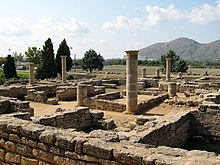
By mixing the Romans with the Iberian indigenous population and introducing Latin as the administrative language, Mallorca was Romanised over the course of the next hundred years . In addition to the Christianization between the 2nd and 4th centuries, which also took place from mainland Spain , the adoption of the language is the most lasting influence of Rome's reign, which still has an effect today in the form of the Catalan language . Even the island name is derived from the Roman name Insula Maior or Maiorica for the "large" Balearic island, in contrast to Insula Minor for the "small" Menorca . The name Columba , which was previously used for Mallorca, has not been preserved.
During the 588 years of Roman rule Mallorca experienced its first heyday. The reason seems to have been the central location in the western Mediterranean. After the Roman conquest of the North African provinces, the island was far from the embattled border provinces of the empire until the Great Migration . The fortified talayot villages on Mallorca lost their importance. The new foundations, including Sinium (probably Sineu ) and Cunium near Manacor , were laid out according to the Roman model, with all the amenities of the new civilization such as water and sewer pipes, baths, theaters, shopping streets and public places. Pollentia was the most important city on the island before Palma. The ruins of the former capital near Alcúdia have now been uncovered and can be visited. In Palma, which has been built over again and again, hardly any Roman traces have been preserved. The main sources of income in Roman times were agriculture, trade and handicrafts, the main goods being wheat, wine and olive oil.
After the division of the empire in 395, Mallorca and the Balearic Islands belonged to the Western Roman Empire , which slowly disintegrated under the pressure of the Germanic migrations . As early as 426 the Vandals under their King Geiseric plundered and destroyed the Mallorcan Pollentia. The Germanic Vandals (also: Vandals) had founded an empire from 409 next to the non-Germanic Alans in southern Spain, today's Andalusia , after they had been forced to plunder by the Goths, who evaded the Huns in 375 from their traditional settlement areas on the Oder and Tisza Gaul had moved. In 429 the Vandals and Alans, numbering about 80,000, crossed to Africa and in 439 conquered the granary of the Western Roman Empire, the province of Africa Proconsularis with the capital Carthage . They also fell into their hands in the port of Carthage, with the help of which the Vandals were able to occupy and plunder Rome and conquer the islands of the western Mediterranean. In 465 Mallorca came to the Vandal Empire now ruled from Carthage.
The rule of the Vandals over the Balearic Islands is characterized by multiple persecutions of Catholics. The Vandals were also Christians , but of the Arian faith, while the Catholic branch of the Christian religion had spread to the Balearic Islands within the Western Roman Empire . In the year 484 under King Hunerich a decree was even issued in the Vandal Empire, which demanded the conversion of all Catholics to Arianism. Only King Hilderic allowed Catholicism in 523, but was overthrown in 530 by Gelimer , under whose rule reprisals against the Catholic Christians were recorded again. These only ended with the destruction of the Vandal Empire in North Africa in 534 by the Eastern Roman Empire . Culturally, the vandals have left no traces on Mallorca. There was also no mixing of the Germanic rulers with the long-established population. Culture and beliefs were probably too different for that and the vandals settling on the islands too few in number.
middle Ages
After that of Constantinople , the former Byzantium (Greek Byzantion , Latin Byzantium), the Eastern Roman Empire ruled after a military defeat against the Vandals in 468 in the year 474 the rule of the Vandal Empire over the western Mediterranean islands, the Byzantine Emperor Justinian I used the Controversy for the throne in Carthage, occupying the city by his general Belisarius in 533. The envisaged enthronement of King Hilderic, who was allied with the Eastern Roman Empire during his reign, could not take place because he was executed by King Gelimer in September 533, after Belisarius landed in Africa and the battle of Ad Decimum south of Carthage, which was victorious for Eastern Europe . So it was decided in 534, after Gelimer's surrender in Tricamarum ( Numidia ), to incorporate the Vandal Empire in its entirety into the Eastern Roman Empire. As a result, Mallorca came under Byzantine suzerainty for the next 200 years or so.
First belonging to the province of Sardinia , then to the province of Mauritania II of the Eastern Roman or Byzantine Empire, the western peripheral location within the empire gave the Balearic Islands a certain degree of independence and autonomy. This increased all the more when Byzantium was increasingly graced and threatened from outside. The introduction of Greek as the administrative language of the empire by Emperor Herakleios (reign from 610 to 641) had no linguistic effects on the Balearic Islands. The Catholic faith of the islanders was able to develop freely again and Mallorca and the other islands became a place of refuge in the 7th century for Christians displaced in the Mediterranean area by the Arab expansion and the associated spread of Islam .
Arab conquerors first came to Mallorca in 707, but were unable to establish themselves. After extensive independence from Byzantium from the middle of the 8th century, the Franconian Empire exercised a kind of protective rule over the Balearic Islands from 754 to 798. Frankish troops defended the islands from Arab raids in 799. In 813 the Count of Apulia , a follower of King Bernhard of Italy (a grandson of the Frankish emperor Charlemagne ), protected the Balearic Islands from another raid by the Muslim Arabs, in which he freed 500 Christian hostages from their power. After that there was a non-aggression pact between Muslims and the islanders of the Balearic Islands, which they did not adhere to. After attacks on Muslim ships, in which the Mallorcans made rich booty, the Emir of Córdoba, Abd ar-Rahman II , sent a punitive expedition to the Balearic Islands in 848 . After high losses on the part of the islanders, they were prepared to comply with the non-aggression pact in exchange for maintaining their independence and to pay the emir a required tribute.
In 859 the Balearic Islands were invaded and plundered by a Viking fleet who carried out raids along the Iberian Atlantic and Mediterranean coasts. Coming from Murcia , they landed one after the other on Ibiza, Formentera, Mallorca and Menorca. In contrast to later voyages of the Normans into the Mediterranean, the Vikings did not intend to conquer permanent possessions.
After more than 50 years of truce, the Balearic Islands were incorporated into the Muslim sphere of influence. General El Jaulani conquered the strategically interesting islands for the emirate of Córdoba in 902 and became the first Islamic governor of Mallorca in the city of Palma, now known as Medina Mayurka. The Moors and Arabs ruled from the tenth to the thirteenth centuries when Mallorca was conquered by the Christians. The construction of dry stone walls (parets seques) for the construction of terraces, the irrigation ditches and wells that were used for agriculture come from the Arab period. Place names that indicate Arabic or Berber origins are still preserved today. In 1229 Jaume I of Aragon and Catalonia invaded Medina Mayurka and defeated the military power of the Moors, who either had to flee or come to terms with the new masters.
Jaume founded the Kingdom of Mallorca and shortly afterwards construction began on the cathedral, which was consecrated to the Virgin Mary according to the express will of the King. His son, Jaume II. And King of Mallorca, had palaces and residences built in many places. Jaume III. , the king's nephew, was killed in the Battle of Llucmajor in 1349 and the kingdom's independence was lost.
Modern times
Under the Catholic Kings , Mallorca was an independent part of the Crown of Aragón and later of Spain , but it lost its independence at the beginning of the 18th century.
Only with the reintroduction of democracy in Spain, the Balearic Islands have been an autonomous territory again since 1983, when the Statute of Autonomy was signed. The islands got an autonomous government and each island got its own administrative council. While the Mallorcans were prohibited from communicating in their own language under Franco, Mallorquins became the official language from now on. The Diada de Mallorca on September 12th is a Majorcan holiday . As this is not a public holiday, the day will be worked normally.
| year | 1842 | 1877 | 1900 | 1920 | 1940 | 1960 | 1981 | 2001 | 2011 |
|---|---|---|---|---|---|---|---|---|---|
| Residents | 173.987 | 232.148 | 250,481 | 278,686 | 330,569 | 362.202 | 612,524 | 676.909 | 873.414 |
Events
- around 3500 BC Chr .: The first prehistoric traces come from this time .
- around 1500 BC BC: The Talaiot culture , the Balearic variant of the Bronze and Iron Ages begins. The Talaiot culture has trade relations with the Phoenicians and Greeks .
- 123 BC BC : Roman invasion; Caecilius Metellus Balearicus founds the cities of Pollentia (today Alcúdia ) and Palma (from Latin palma , palm of victory).
- 465 AD: The Vandals conquer the Balearic Islands.
- 534 AD: Eastern Roman troops conquer Mallorca.
- 902 : Mallorca is conquered by the Moors .
- 1229 : During the Reconquista Mallorca is conquered by the Aragonese troops under Jaume I.
- 1276 : Jaume II proclaims the Kingdom of Mallorca .
- 1349 : Pere IV of Aragón drives out Jaume III. and subsequently Mallorca becomes a province of Aragon. Until the autonomy of 1983 the island was ruled from the mainland.
- 19th century: beginning of tourism; The stay of the Polish composer Frédéric Chopin and the French writer George Sand (A Winter in Mallorca) in Valldemossa is famous .
- 1936 : During the Spanish Civil War , Mallorca falls under the control of the Falange .
- 1960s: mass tourism sets in.
- 1978 : Spain becomes a parliamentary monarchy.
- 1983 : The Balearic Islands become an autonomous region .
-
2009 : In a bomb attack on July 30th at 1:45 p.m. in front of a police barracks in Palmanova in the municipality of Calvià, two police officers were killed and others injured. The attack was carried out using a sticky bomb on a police vehicle. A second bomb was discovered and detonated in a controlled manner. As a result, airports and ports on the island were temporarily closed for the terrorist search. Almost a week and a half after the attack, the Basque terrorist organization ETA confessed to the attack.
On August 9, four explosive devices exploded in Palma at 12:00 p.m. in the closed Cafetería Nica in the city center, at 2:25 p.m. in the pizzeria La Rigoletta on the beach in Can Pere Antoni, and at 4:03 p.m. in Café Enco on Portitxol beach and at 6:10 p.m. in the shopping center under Plaça Major in the city center. The attacks were announced by telephone at 11:30 a.m. that day. The explosives were all in the ladies' room. Nobody was injured in the attacks.
Prehistoric sites
- Capocorb Vell (municipality of Llucmajor )
- Necròpolis de Son Real (east of Can Picafort, municipality of Santa Margalida )
- Novetiforme Alemany ( Magaluf , Calvià municipality )
- Poblat Talaiòtic de S'Illot ( S'Illot , municipality of Sant Llorenç des Cardassar )
- Poblat Talaiòtic de Son Fornés (municipality of Montuïri )
- Talaiot del Puig Figuer ( Artà municipality )
- Sa Canova de Morell (road to Colonia de Sant Pere , Artà municipality )
- Talaiot de sa Cova de sa Nineta (municipality of Santa Margalida )
- Dolmen de s'Aigua Dolça ( Artà municipality )
- Ses Païsses ( Artà municipality )
- Ses Talaies de Can Jordi ( Santanyí municipality )
- Poblat prehistòric de s'Heretat (road to Canyamel , Capdepera municipality )
- Poblat prehistòric de s'Hospitalet Vell (road to Cales de Mallorca , municipality of Manacor )
administration
Mallorca belongs to the autonomous area of the Balearic Islands and is governed by the Govern de les Illes Balears from its capital Palma . On the basis of Articles 30 to 38 of the Statute of Autonomy of the Balearic Islands, their government has competences, among other things. a. in the fields of education, health, tourism and social affairs. The island of Mallorca also has one of the three island councils ( Consell Insular ) alongside Menorca and Ibiza . These decentralized island councils in turn have partial competencies in the areas of culture, road construction, railways, construction, youth protection and waste disposal.
On May 22nd, 2015, new elections were held for the Island Council, which consists of 33 seats. Ten seats went to the Partido Popular , the Socialists got seven seats, MÉS got six seats, Podemos got five seats, PI got three seats and Ciudadanos got two seats.
With the exception of the municipality of Palma, the six landscape zones of Mallorca do not form any administrative units. However, their boundaries coincide with the municipal boundaries, with several municipalities forming a landscape zone. Politically, the island is divided into 53 municipalities with the administrative seat (municipis) .
Communities
Alaró • Alcúdia • Algaida • Andratx • Ariany • Arta • Banyalbufar • Binissalem • Búger • Bunyola • Calvia • Campanet • Campos • Capdepera • Consell • Costitx • Deià • Escorca • Esporles • Estellencs • Felanitx • Fornalutx • Inca • Lloret de Vistalegre • Lloseta • Llubí • Llucmajor • Manacor • Mancor de la Vall • Maria de la Salut • Marratxí • Montuïri • Muro • Palma • Petra • Pollença • Porreres • Puigpunyent • Santa Eugènia • Santa Margalida • Santa Maria del Camí • Santanyí • Sant Joan • Sant Llorenç des Cardassar • Sa Pobla • Selva • Sencelles • Ses Salines • Sineu • Sóller • Son Servera • Valldemossa • Vilafranca de Bonany
Other places / districts
S'Arenal • Cala Bona • Cala d'Or • Cala Figuera • Cala Llombards • Cala Millor • Cala Rajada • Cala Santanyí • Cales de Mallorca • Can Picafort • Costa de Canyamel • Colonia de Sant Jordi • Colonia de Sant Pere • Es Llombards • Magaluf • Orient • Palma Nova • Peguera • Port de Pollença • Port de Sóller • Portocolom • Porto Cristo • Portopetro • Randa • Sa Calobra • Sa Coma • Santa Ponça • Sant Elm • Sa Ràpita • Son Carrió • Son Macià • Son Serra de Marina
Infrastructure
Air traffic
Mallorca has been accessible by air since 1916.
Aeropuerto de Son Sant Joan
Palma de Mallorca Airport on the island of Mallorca is one of three international airports in the Balearic Islands (next to Ibiza and Menorca). It is located eight kilometers east of the island's capital Palma de Mallorca and is the third largest airport in Spain after Madrid-Barajas and Barcelona-El Prat.
The airport has two runways approximately three kilometers long and 45 m wide. The maximum capacity is currently 32 million passengers per year. Up to 18,000 passengers per hour or 400,000 per day can be handled.
There are 88 parking positions with 70,000 m² available for passenger aircraft. 34 of these are directly connected to the terminal via passenger boarding bridges. The freight center has an area of 6,000 m². 4,800 parking spaces for vehicles are available.
A new departure area was opened in Terminal C in May 2010, increasing the airport's capacity from 25 million to 32 million passengers. The expansion of the capacity to 38 million passengers by 2015 is planned.
Aeródromo de Son Bonet
The Aeródromo de Son Bonet is an airfield in the municipality of Marratxí in the district of Es Pont d'Inca on the Balearic island of Mallorca. It is located four kilometers from the center of the capital Palma on the road from Palma to Inca. Today the Son Bonet airfield with various hangars is used by civil aviation. Among other things, the first Aero Club de Mallorca (ACM) is located there with a flight school, helicopter squadron and fire-fighting aircraft for fighting forest fires, as well as a company for helicopter pilot training.
Ports
Mallorca has a total of 43 port facilities with 14,280 berths.
- Cala d'Or ( marina )
- Cala Figuera ( fishing port , marina)
- Cala Major (sports harbor)
- Can Picafort (marina)
- Cala Rajada (fishing port)
- Colonia de Sant Jordi (marina, fishing port)
- Colonia de Sant Pere (fishing port)
- Palma (sea port, marina, fishing port)
- Portals Nous / Puerto Portals (yacht harbor)
- Port d'Alcúdia (marina, fishing port)
- Port d'Andratx (marina, fishing port)
- Port de Pollença (marina, fishing port)
- Port de Sóller (marina, fishing port)
- Portocolom (fishing port)
- Porto Cristo (fishing port)
- Portopetro (marina, fishing port)
- S'Arenal (marina)
Rail transport
Road traffic
There is no sign of overtaking on the island . If the road can be seen from a distance of less than 200 meters and 100 meters before the crests of the road, the general no-overtaking rules apply.
The following speed limits exist on the island
| Max. km / h | Location |
|---|---|
| 50 | inside city limits |
| 90 | Country road |
| 100 | Expressway |
| 120 | Highway |
One-way streets are indicated by a round sign with white bars on a red background. Towing broken down vehicles is strictly prohibited for private individuals.
There are also special features when parking, such as the regulation to park outside of multi-storey car parks only on curbs colored blue (with required parking permit).
economy
The Mallorcans have one of the highest per capita incomes in Spain. The main source of income is the tourism service sector with 75 percent, followed by the construction industry with around 10 percent. Almost three quarters of the island are used for agriculture. The agriculture provides 11 percent of jobs on the island, but contributes only 2.5 per cent of gross national income.

In addition, mining (especially marble extraction ), light industry ( leather , ceramics , imitation pearls , glass ) and fishing are important branches of the economy.
tourism
Tourism is the backbone of the Mallorcan and the rest of the Balearic economy. In 1960 around 360,000 visitors came, in 1970 there were already more than 2 million. In 2007 around 9.91 million tourists came to Mallorca, which puts the island well ahead of the second most important tourist region in Spain, Catalonia . In 2007, 35.8% (3.548 million) of the visitors came from Germany, 23.2% (2.3 million) from Great Britain and 21.6% (2.14 million) from Spain. 2.3% (230,700) came from Switzerland and 1.5% (146,564) from Austria.
The Son Sant Joan Airport in 2007 has handled about 23 million passengers, of which 9.9 million are attributable to the tourist visitors to the island. A good 98% of the Mallorca tourists came by plane, only 203,000 came to the island by ship. A total of 287,438 registered hotel beds were available to guests in 1,603 hotel complexes as of 2007. Estimates put the number of unreported beds at around 80,000. In 1989 there were 1,711 facilities with 241,730 beds. In the years after 2007 these numbers declined.
The occupation of tourism with a special tax ("Ökotaxe", ecotasa ), which began in 2002, was discontinued in 2003.
Due to the large number of German tourists, Germans joke that Mallorca is also the 17th state ; other German names for the island are Malle or, in the past, due to the affordability at the time, cleaning women island . The town of S'Arenal has almost become a symbol for German mass tourism , which does not affect large parts of the island . The term Ballermann is often a synonym and cliché for the extensive party tourism on Mallorca and especially S'Arenal. Magaluf has a similar meaning for English tourism . But there is also a not inconsiderable number of individual tourists who hike or cycle in the Serra de Tramuntana , for example, and around 35,000 foreign residents who have settled in Mallorca and, in some cases, also integrate into the local society.
The development of tourism in Mallorca is currently subject to change. The massive expansion of tourism has led to massive environmental problems and a declining quality standard in many holiday resorts on Mallorca: the water supply on Mallorca has reached its limits. The island's natural water poverty was exacerbated by mass tourism and has threatened the local flora and fauna ever since. The high demand of the hotel and golf facilities can only be met by operating expensive water treatment systems and importing water reserves. At the same time, due to seasonal overloads in the sewage treatment plants, wastewater enters the bathing bays unfiltered and unbalances the sensitive ecosystem of the underwater world. Weaknesses in waste disposal and hotels that are no longer in use represent a further problem for the tourist strongholds, the building structure of which also drives urban sprawl and thus destroys the original landscape. According to Greenpeace , 23% of the island's coastal area is now sealed, with Calvià being particularly emphasized among the communities with built-up coasts.
To put a stop to this development, for example, in the area of Playa de Palma , which is considered an important center of mass tourism, three billion euros are to be invested: the dismantling or modernization of outdated hotel facilities and the improvement and creation of parks and green areas are to be the district be the first in Europe to make it climate-neutral and make it more attractive as a holiday region for tourists with high demands in the long term. In order to prevent the negative effects of mass tourism on nature and the environment and to improve the tourist infrastructure, a tourism tax was introduced for all Mallorca tourists in summer 2016.
See also
- Asociación de Industriales de Mallorca , other branches of industry in Mallorca
Culture
Long before the beaches, visitors to the island became interested in the numerous monuments, important buildings, museums, art galleries and the literature of Mallorca. But not only the monuments and sights of Palma - the cathedral, the Bellver Castle, the Palacio Real, the Lonja, the Gran Hotel, the Museo de Mallorca, patrician houses such as Can Vivot, Can Oleza, Casal Solleric and about twenty galleries for modern art Art, but also the monasteries, the defense towers, churches, town halls and museums of the 52 other cities of Mallorca form the architectural and artistic wealth of Mallorca.
The annual opera season, the subscription concerts of the Ciutat de Palma symphony orchestra or the Un invierno en Mallorca program enrich cultural life in the winter months, and in summer it is the outdoor classical music festivals or the modern music, jazz concerts as well as ballet and theater performances.
The public foundations do their part to spread art and enjoy it. The Pilar and Joan Miró, la Caixa, Sa Nostra and March foundations are expanding the range of exhibitions that can be seen regularly in the state exhibition centers Sa Llotja, Casal Solleric, Ses Voltes, Bellas Artes or Casa de Cultura.
The literary and educational cycles, which are carried out by the University of the Balearic Islands together with private institutions, take place in the comfortable and technically well-equipped event halls in and outside the capital.
Museums
- Artà Regional Museum
- It baluard
- Els Calderers
- Ca'n Prunera Museum
- Historical Museum of Manacor
- Museu Etnològic Muro
- Fortalesa de Sant Carles
- Son Marroig
- Valldemossa Charterhouse
Monasteries and hermitages
- Cartoixa de Valldemossa
- Ermita de Betlem ( Artà )
- Ermita de Bonany ( Petra , 317 m above sea level)
- Ermita de la Trinitat ( Valldemossa , 540 m above sea level)
- Ermita de la Victòria (near Alcúdia , at an altitude of 400 m)
- Ermita de Santa Magdalena ( Inca , at 304 m altitude)
- Ermita de Sant Miquel ( Montuïri , at an altitude of 246 m)
- La Trapa (near Sant Elm )
- Santuari de Cura ( Puig de Randa , Algaida , 540 m above sea level)
- Santuari de Lluc ( Escorca / Lluc at 550 m altitude)
- Santuari de Montision ( Porreres , at an altitude of 263 m)
- Santuari de Sant Salvador ( Felanitx , at 510 m height)
- Santuari des Puig de Maria ( Pollença , 333 m above sea level)
- Santuari de la Consolació ( Santanyí , at a height of 199 m)
Attractions

The infrastructure for tourism in almost all tourist centers on the island has been greatly expanded. Travel agencies organize day trips to visit the caves of Porto Cristo and Artà, the Roman ruins of Pollentia in Alcúdia, the beach of Formentor, the Charterhouse of Valldemossa, the port of Cala Figuera and the islands of Dragonera and Cabrera.
Other possibilities are aqua parks, auto safaris, dolphinariums, plants with exotic birds, historical gardens, or the s'Albufera nature park near Alcúdia. The nightlife can be seen in the tourist centers of Palma and other places in Mallorca along entire streets, where bars, pubs and discos are lined up. There is a casino 20 kilometers from Palma.
- Botanicactus - Botanical ( cactus ) garden near Ses Salines
- Cabrera - National Park on the island off the coast to the south
- Cap Formentor - the northernmost point of Mallorca
- Castell de Bellver - fortress in Palma
- Castell d'Alaró - castle ruins at an altitude of 825 meters on the Puig d'Alaró near Alaró
- Castell del Rei - At an altitude of 476 meters near Pollença
- Castell de Capdepera - Within the village of Capdepera
- Castell de Santueri - At 408 meters above sea level near Felanitx
- Castell de sa Punta de n'Amer - defense tower between Cala Millor and Sa Coma
- Coves d'Artà - cave system near Artà near Canyamel
- Coves de Campanet - cave in the northwest between Inca and Alcúdia
- Coves del Drac - stalactite cave with a large underground lake near Porto Cristo
- Coves dels Hams - stalactite cave near Porto Cristo
- Coves de Gènova - cave near Palma
- Es Baluard - Museum of Modern and Contemporary Art Palma
- Ferrocarril de Sóller - A historic railway from Palma to Sóller
- La Granja - winery and museum of Mallorcan life
- La Seu - Palma Cathedral
- Planetarium Mallorca in Costitx
- Santuari de Lluc - monastery near Escorca in the northwest
- Ses Païsses - Talaiot settlement near Artà
- Son Marroig - 16th century manor between Deià and Valldemossa
- Torrent de Pareis - torrent through a canyon on the northwest coast near Sa Calobra , north of Sóller
media
Newspapers
- Última Hora (Spanish / Castilian) - founded in 1893, Grup Serra / Grupo Serra publishing group
- Diario de Mallorca (Spanish / Castilian) - Editorial Prensa Ibérica publishing group
- Diari de Balears (Catalan) - founded in 1923, Grup Serra / Grupo Serra publishing group
- El Mundo edition: Baleares (Castilian / Catalan), RCS MediaGroup publishing group.
- Majorca Daily Bulletin (English) - founded in 1962, Grup Serra / Grupo Serra publishing group
- Mallorca Zeitung (German) - Editorial Prensa Ibérica publishing group
- Mallorca Magazin (German) - founded in 1971, publishing group Grup Serra / Grupo Serra
- EL AVISO (German) - founded in 1998, free advertising paper of EL AVISO de Mallorca SL
- Die Inselzeitung (German) - free monthly newspaper from Medienhaus Mallorca SL
- Associació de la Premsa Forana de Mallorca (Catalan), founded in 1978, publishing group with 46 regional magazines.
Radio station
- Cadena Dial (98.4 MHz)
- Cope (99.2 MHz)
- Europe FM (102.6 MHz)
- Flaix FM (100.6 MHz)
- IB3 radio (Alcúdia / Andratx / Sóller 89.2 MHz, Calvià 92.7 MHz, Capdepera 96.4 MHz, Palma 106.8 MHz, Pollença 89.7 MHz)
- Inselradio (95.8 MHz, German)
- KISS FM (Palma 89.5 MHz)
- Lot 40 Principales (94.1 MHz)
- M80 (Palma 102.3 MHz)
- Maxima FM (Palma 106.1 MHz)
- Muro Radio (Muro 107.1 MHz)
- Onda Melodia (95.1 MHz)
- Radio Artà (Artà 107.9 MHz)
- Radio Balear (Alcúdia 101.9 MHz, Inca 101.4 MHz, Palma 99.9 MHz)
- Radio Calvià (Calvià 107.4 MHz)
- Radio Clásica (Palma 87.9 MHz, Pollença 95.4 MHz)
- Radio Diario (103.9 MHz)
- Radio Farbenspiel (formerly Radio Aleman, web radio in German)
- Radio 3 (92.3 MHz)
- Radio 3, Alfabia (Pollença 97.4 MHz)
- Radio 5 Todo Noticias (Palma 104.5 MHz, Pollença 99.7 MHz)
- Radio GlobalFM Mallorca (90.4 MHz)
- Radio Mallorca - Cadena Ser (103.2 MHz)
- Ràdio Murta (Montuïri 88.4 or 91.8 MHz)
- Radio Nacional de España (90.1 MHz, Palma 93.2 MHz)
- Radio Última Hora Punto Radio (98.8 MHz, in the north of the island 100.2 MHz)
TV channel
Terrestrial television reception on Mallorca has been completely converted to digital television reception since January 11, 2010 and is only possible via a DVB-T receiver. So far there have only been 12 analog television programs. A total of 36 channels will be supported by the new digital television reception, eight of which will be broadcast in Catalan.
- IB 3
- TVE Balear
- M-7
- Canal 4
- TV 3
- German Mallorca TV
sport and freetime
As an island, Mallorca is predestined for all kinds of water sports . There are numerous sailing , canoeing , diving , swimming and water skiing courses . A wide variety of alpine sports are practiced in the Serra de Tramuntana mountains, especially mountain hiking ( trekking ), mountain biking and climbing . Due to the favorable climate and the varied topography, cycling in winter is not only widespread among professionals, but increasingly also among ambitious amateur athletes.
There are 21 publicly accessible golf clubs in Mallorca (Golf Son Gual, Golf Park Puntiró, Son Quint, Son Muntaner Golf, Son Vida Golf, Real Club Bendinat, Golf de Poniente, Golf Santa Ponca I, Golf de Andratx, Golf Son Termens, Golf de Pollenca, Club de Golf Alcanada, Golf Capdepera, Pula Golf, Canyamel Golf, Golf Son Servera, La Reserva Rotana Golf, Vall d'Or, Golf Maioris, Golf Son Antem West, Golf Son Antem East).
With 4 large tennis facilities in Paguera, Son Vida, Santa Ponca and Portals Nous, Mallorca has ideal conditions for tennis players.
Trotting races are held on the weekends on two horse racing tracks in Palma and Manacor. Palma has five sports centers and municipal swimming pools such as that of Son Hugo , which was inaugurated on the occasion of the Universiade Palma in 1999. The Real Mallorca football club usually plays every fortnight at its Son Moix stadium .
As one of the most intensive holiday and leisure regions in Europe, Mallorca offers almost all climate-related indoor and outdoor sports.
See also
Picture gallery
literature
- Thomas Freller: The history of Mallorca. Thorbecke, Ostfildern 2013, ISBN 978-3-7995-0424-9 .
- David Ginard i Féron: Mallorca during the Franco dictatorship. Politics, economy and society 1939–1975. Verlag Walter Frey, Berlin 2001, ISBN 3-925867-58-9 .
- Claudia Kaiser: Supply and demand structure of a mass tourism destination on the east coast of Mallorca. In: Hallesches Jahrbuch für Geoswissenschaften. Vol. 23. Halle (Saale) 2001, pp. 123-130.
- Archduke Ludwig Salvator : The Balearic Islands. Described in words and pictures. 7 vols. Woerl, Leipzig 1884–1897.
- François Maher Presley : Mallorca - Reality or Dream . Edited by Jörn Eckmann. in-Cultura.com , Hamburg 1995, ISBN 3-930727-01-3 .
- François Maher Presley : Mallorca , in-Cultura.com , Hamburg 2014, ISBN 978-3-930727-35-3 .
- Thomas Schmitt: Ecological landscape analysis and assessment in selected units of space in Mallorca as the basis for environmentally friendly tourism development. In: Earth Science Research. Vol. 37. Wilhelm Lauer, Mainz / Stuttgart 1999.
- Elisabeth and Thomas Schmitt: Mallorca. Spektrum Akademischer Verlag, Heidelberg 2011, ISBN 978-3-8274-2791-5 .
- Ekkehard Schönherr: Modern Mallorca. From the "island with industry" to the "tourist paradise". Logos Verlag, Berlin 2019, ISBN 978-3-8325-4989-3 .
- Petra Schürgers: Local Tourism Systems in Mallorca. In: Düsseldorfer Geographische Schriften Heft 40, Düsseldorf 2005
- Axel Thorer : Mallorca - Lexicon of island secrets. Hoffmann and Campe, Hamburg 2006, ISBN 3-455-50006-4 .
- Heide Wetzel-Zollmann, Wolfgang Wetzel: Mallorca - A journey through the 6,000-year history of the Mediterranean island. Herder, Freiburg im Breisgau 1991, ISBN 3-451-22311-2 .
- Jesús Pastor García, Rutes Amagades de Mallorca, historical travel guide, No. 1–83, 1964–1980, digital library of the University of the Balearic Islands, link
Web links
- Link catalog on Mallorca at curlie.org (formerly DMOZ )
- Consell de Mallorca - Island Council / Government
- Population of the municipalities and towns in Mallorca
- Mallorca - a continental island in the Mediterranean
- Tourism portal
- GOB - Grup Balear d'Ornitologia i Defensa de la Naturalesa
- Map of the island
Individual evidence
- ↑ Island areas of the Balearic Islands
- ^ Origin of Mallorca (contribution by the University of Marburg) ( Memento from May 28, 2012 in the Internet Archive ).
- ↑ A rock that grew out of the sea , interview with geologist Rosa Mateos in Mallorca Magazin 13/2009, pages 62/63
- ↑ Illes Balears: Población por municipios y sexo. (No longer available online.) In: ine.es. January 1, 2012, archived from the original on March 15, 2013 ; Retrieved March 19, 2013 (Spanish).
- ↑ Many Moroccans in the country: Immigrants from Africa make up the largest group of foreigners in 14 places. In: mallorcamagazin.com. Mallorca Magazin , March 16, 2013, accessed on March 19, 2013 .
- ^ A b Joan-Antoni Adrover i Mascaró: 600 questions about Mallorca . 2nd Edition. Hoopoe, Campos 2010, ISBN 978-84-614-1808-4 , The language of the Mallorcans, p. 81 .
- ↑ a b Hans-Ingo Radatz: Mallorcan . Word for word (= gibberish . Volume 124 ). 4th edition. Reise Know-How, Bielefeld 2006, ISBN 978-3-89416-324-2 , Catalan and the languages of Spain, p. 14 .
- ↑ Kathrin Langgut: Mallorcan, Catalan, Spanish - tourists' perception of a problematic language situation . GRIN, 2006, ISBN 978-3-638-56242-3 , Sprachpolitik, pp. 17 ( limited preview in Google Book search).
- ↑ a b c Jaume Alzina Mestre, Miquel Pastor Tous, Jaume Sureda Negre: The Talayot settlement Ses Païsses. "Sa Nostra" Caixa de Balears, Govern de les Illes Balears - Conselleria d'Educació i Cultura, Ajuntament d'Artà
- ↑ INE
- ↑ Dead in explosion in front of police barracks on Mallorca. Spiegel Online GmbH, accessed on July 30, 2009 .
- ↑ Silke Droll: Mourning and Anger , article in Mallorca Zeitung No. 483, page 7
- ↑ cf. Eta is bombing its 50th anniversary at welt.de, July 30, 2009
- ↑ The attack shakes Mallorca's tourism industry. Spiegel Online GmbH, accessed on July 31, 2009 .
- ↑ cf. After the attack, authorities seal off Mallorca at Spiegel Online , July 30, 2009
- ↑ cf. ETA is committed to the Mallorca attack at diepresse.com, August 9, 2009
- ↑ cf. Third bomb in Palma explodes at focus.de, August 9, 2009
- ↑ Four bombs and many false warnings , chronology in Mallorca Zeitung No. 484, pages 4 and 5
- ↑ https://mallorcamagazin.com/nachrichten/politik/2015/05/25/42577/horror-wahlnacht-fur-mallorcas-konservative.html Retrieved October 23, 2018.
- ↑ Traffic regulations on Mallorca , accessed on April 15, 2013.
- ↑ "Mallorca Magazin - Special Berlin", June 2008, page 6 (information from the statistical yearbook)
- ↑ Information from the hotel association
- ↑ Perger, Werner A .: Conspiracy theories on Ballermann , published on July 17, 2020 on Zeit Online , accessed on July 18, 2020
- ↑ Paradises under threat: Mallorca and the Balearic Islands - holiday paradise on the edge ( Memento from July 29, 2010 in the Internet Archive )
- ↑ Jens Wiegand: Tourism on Mallorca: Problems and Perspectives . In: Hans-Ingo Radatz (Hrsg.): Mallorca: Studies on language, literature and culture; results of the viatge cultural 1996 organitzat pel Consell Insular de Mallorca . TU Chemnitz , Chemnitz 1997, OCLC 254025441 ( archive.org ).
- ^ Environmental "X-ray image" from Greenpeace . Balearic Islands in the middle of the Spanish regions. 29 “black points”. In: Mallorca Magazin . No. 24/2015 . Grupo Serra, Palma 2015, p. 12 .
- ↑ Too few tourists in Spain - government wants to help. In: t-online.de. July 25, 2009. Retrieved April 29, 2018 .
- ↑ Sybille Nobel-Sagolla: Mallorca: Playa de Palma wants to get away from the Ballermann image. In: Welt Online . December 4, 2009, accessed April 29, 2018 .
- ↑ Ralph Schulze: Mallorca introduces vacation tax. Surcharge on malls. In: tagesspiegel.de. Der Tagesspiegel , October 16, 2015, accessed on February 19, 2016 .
- ^ TDT reception Spain ( Memento from February 18, 2010 in the Internet Archive ).
Coordinates: 39 ° 37 ' N , 2 ° 59' E




